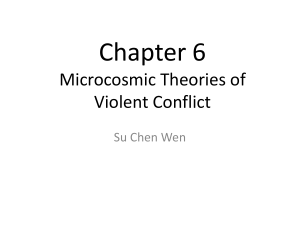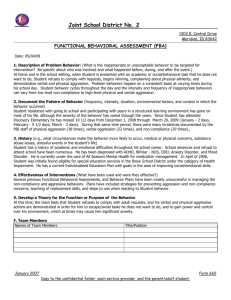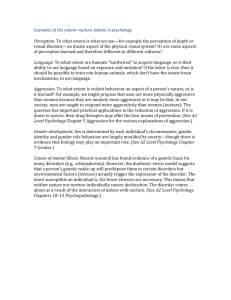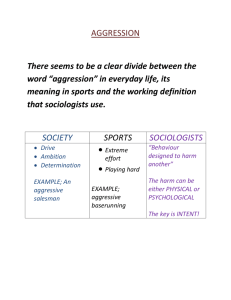Frustrations, Appraisals, and Aversively Stimuiated Aggression
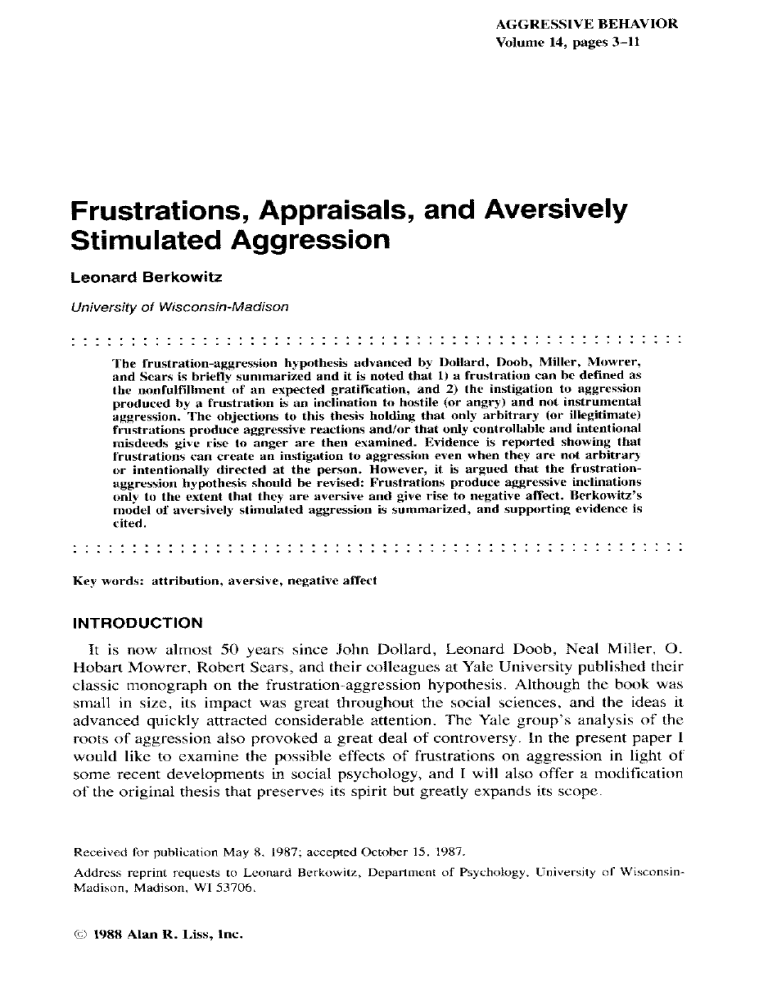
AGGRESSIVE BEHAVIOR
Volume 14, pages 3-11
Frustrations, Appraisals, and Aversively
Stimuiated Aggression
Leonard Berkowitz
University of Wisconsin-Madison
Ihe frustration-aKSression hypothesis advanced by Dollard, Doob, Miller, Mowrer, and Scars is briefly summarized and it is noted that 1) a frustration can be defined as the nonfulfillment of an expected gratification, and 2) the instigation to aggression produced by a frustration is an inclination to hostile (or angry) and not instrumental aggression. The objections to this thesis holding thai only arbitrary (or illegitimate) frustrations produce aggressive reactions and/or that only controllable and intentional misdeeds give rise to anger are then examined. Evidence is reported showing that frustrations can create an instigation to aggression even when they are not arbitrary or intentionally directed at the person. However, it is argned that the frustrationaggression hypothesis should be revised: Frustrations produce aggressive inclinations only to the extent that they are aversive and give rise to negative affect. Berkowitz's model of aversively stimulated aggression is summarized, and suppt»rting evidence is tited.
Key words: attribution, aversive, negative affeet
INTRODUCTION
It is now almost 50 years since John Dotlard, Leonard Doob, Neal Miller, O.
Hobart Mowrcr, Robert Sears, and their colleagues at Yale University published their classic monograph on the frustration-aggression hypothesis. Although the book was small in size, its itnpact was great throughout the social scietices. and the ideas it advanced quickly attracted considerable attention. The Yale group's analysis of the roots of aggression also provoked a great deal of controversy. In the present paper I would like to examine the possible effects of frustrations on aggression in light of some recent developments in social psychology, and I will also offer a modification of the original thesis that preserves its spirit but greatly expands its scope.
Received for pubiicistion May 8. 1987; accepted October 15. 1987.
Address reprint requests to Leonard Berkowit/, Deparlmctit of Psychology. University of Wi.sconsin-
Madison, Madison, Wl 53706.
Cg) 198S Alan R . Liss, Inc.
4 Berkowitz
SOME DEFINITIONS AND DISTINCTIONS
Before we proceed any further T will define my terms. First, along with most social psychologists. I regard aggression as any behavior (physical or verbal) that is performed with the intention to harm someone (either physically or psychologically).
Such a conception of aggression, held by the great preponderance of investigators in this area, is identical with the position taken by Dollard and his colleagues [1939] that the goal of aggression is to inflict injury. This is not to say. however, that the attacker only, or even mainly, wants to do harm. Again aligning myself with most researchers,
1 believe it is also important to draw the distinction between instrumental and hostile aggression first made by Feshbach [1964] and now widely accepted by most social psychological investigators of aggression [e.g.. Baron, 1977; Rule, 1974]. Where all aggression is a deliberate attempt to injure someone, in hostile (or angry) aggression the primary goal is to hurt, while instrumental aggression is oriented chiefly toward the attainment of some other objective such as money, social status, or territory.
Dollard and his associates had not recognized the necessity of making this differentiation. They had presented two basic propositions in their monograph: one maintaining that every act of aggression can be traced to a prior thwarting, and the second holding that every frustration creates an instigation to aggression. We can accept the second postulate without agreeing with the first. The first statement insisting that every aggressive action stems from some earlier frustration essentially holds that all aggression is alike, at least in origin, and that every attempt to hurt someone can be reduced ultimately to hostile aggression. The Yale group apparently did not consider that instrumental aggression can be learned much as other instrumental behaviors are learned. Aggressive behavior does not always stem from some earlier failure to obtain a desired goal. We thus should say only that frustration generates an inclination to hostile (or angry) aggression.
Besides distinguishing between types of aggression, it is advisable to be clear as to just what is a frustration. This word obviously is employed in many different ways.
in psychologists' technical discussions as well as in everyday language usage, so that the Yale psychologists' definition, "an interference with the occurrence of an instigated goal-response," has not always been understood, ln order to minimize this ambiguity for a contemporary audience, I think it is helpful to translate the 1939 S-R behavior theory terminology into cognitive terms. There is an important clue as to how this can be done in one passage in the monograph in which the authors quote a couplet from Prior: "Say what can more our tortured souls annoy/ Than to behold, admire, and lose our joy?" Without going further into this matter, we can s a y without violating the essentials of the Yale group's analysis [see Berkowitz, 1978]— that frustration is an obstacle to the attainment of an expected gratification [Dollard et al., 1939). Any truly adequate test of the Yale psychologists' thesis must therefore recognize that people are not necessarily frustrated when they are deprived of some attractive goal. They also have to have been anticipating the pleasures they would experience at reaching this objective.
THE ROLE OF APPRAISALS AND ATTRIBUTIONS
Do Only Improper Frustrations Produce Aggressive Reactions?
The publication of the frustration-aggression monograph was soon followed by a series of objections from other social scientists, most which argued that only some kinds of thwartings produce aggressive inclinations. Many of the critics maintained
Aversivelv Stimulated Aggression 5 thai socially proper frustrations do not create aggressive tendencies and that only illegitimate or arbitrary barriers to goa! attainment have this effect. Pastore's [1952] paper is perhaps the best known criticism along these lines. In this study the subjects were asked how they would respond to various incidents in which they could not fulfill some purpose, for example if a city bus failed to pick them up at a regular bus stop. Not surprisingly, the subjects typically answered that they would not become angry if the thwarting seemed reasonable or proper. And so, they said they would not have been bothered if the bus passing them by had displayed a sign showing it was on the way to the garage.
While Pastorc's fmdings are frequently cited as a demonstration that only illegitimate frustrations have aggressive consequences, the results obviously are actually highly equivocal. For one thing, some of Pastore's incidents do not meet the Yale group's definition of a frustration. Such a condition exists, remember, only when people are kept from reaching a goal they expect to attain. Thus, to go back to the case of the passing bus, if the persons had been aware for some time that the approaching bus was on its way to a garage and would not stop, they would not have expected to get on this bus, and strictly speaking, would not have been frustrated v^hen it went by. But more important, as Pastore himself recognized, his subjects may have given only socially desirable answers to the hypothetical situations described to them. They could well have believed it was unreasonable to become angry at reasonable barriers to their goals, whether they had expected to attain these goals or not. and denied—to others and maybe even to themselves as well—that they would have such an emotional reaction.
Attributions and Frustration Reactions
Attributional interpretations of aggression- or anger-provoking situations are the most recent variation on the only-some-kinds-of-frustration theme. These conceptions maintain that what feelings people have and what actions they undertake depend largely on their appraisal of the emotional event, and especially on their interpretation of its cause. As examples, both Averill [1982, 1983] and Weiner [1985] contend that anger is produced by a perceived deliberate and controllable misdeed. Thus, Averill
[19831 insists that "anger is an attribution of blame," an accusation that someone has committed a wrong. Thwarted persons presumably would not become angry and aggressively inclined unless they thought they had been intentionally and unfairly kept from reaching their goal. From this perspective, chronically aggressive persons are easily provoked because they are all too apt to attribute hostile aims and wrongful intentions toothers [Dodge, 1980].
There is no doubt that the attributions made for a failure to satisfy one's expectations can affect the emotional reactions to this occurrence [e.g., Averill, 1982, 1983; Rule,
Dyck, and Nesdale, 1978; Smith and Ellsworth, 1985; Weiner, 1985]. However, it is possible to explain this type of influence in several ways. 1 have already noted that people often believe their behaviors and even their feelings should follow the appropriate socially defined rules for the particular circumstances. In acceding to these rules they might restrain those emotional reactions that seem socially improper. But then too, even in the absence of these restraints, it is especially unpleasant to think that someone had deliberately blocked one's progress to the goal. The displeasure produced by the perception of such a personal affront undoubtedly adds to whatever displeasure is generated by the frustration itself No, what is really at issue here is not whether attributions have an effect but whether the perception of a deliberate and controllable misdeed is necessary for anger and aggression to arise.
6 BerkowUz
Some Evidence That Even "Proper" Frustrations Produce
Aggressive inciinations
1 cannot here discuss all of the ins and outs of the research bearing on this question.
However, it is worth noting some of the evidence indicating that frustrations can create hostility and aggression even when they are not viewed as arbitrary, illegitimate, and/or a personal affront.
Some relevant observations come from a recent unpublished experiment carried out in my laboratory. Margo Monteith and I were interested in studying the thoughts that came to mind in various aversive incidents and, among other things, we asked the subjects to talk about three different situations that were briefly sketched out for them. In one of these, a supposedly frustrating incident, the participants were to imagine themselves driving to an important job interview and then becoming tied up in a massive traffic jam so that they were in danger of missing their appointment. I doubt whether the subjects believed that someone had intentionally and illegitimately brought about the traffic jam, and it certainly had not been directed at them personally.
However, in talking about this situation they expressed reliably more statements about anger, annoyance, and hostility than in talking about any of the other incidents. The thought of the frustrating event had apparently increased the accessibility of anger and hostility ideas.
These frustration-activated hostile ideas sometimes lead to hostile assessments of other persons. We can see this in the experiment by Burnstein and Worchel [1962].
Groups of male undergraduates were prevented from achieving their goal because one of the members (the experimenter's confederate) persisted in interrupting and asking questions. In the nonarbitrary frustration condition the questioner's task interference was readily attributable to his obvious hearing defect, while there was no such "legitimate" excuse for his interfering behavior in the other, supposedly arbitrary frustration condition. When the subjects evaluated their fellow group members at the end of the session, none of the men exposed to the nonarbitrary frustration were willing to reject the legitimately interfering confederate publicly in their open statements to the group. However, they were more likely to give the confederate very low ratings privately in a questionnaire (for example, on an item tapping their liking for him) in both frustration conditions than in the nonthwarted control condition. The subjects evaluated the person who frustrated them harshly but did not express these judgments overtly when they might have seemed improper.
Frustrations can lead to open aggression as well as to hostile ideas and judgmentsprovided that the situation has not activated other response tendencies incompatible with aggression. The results in an experiment by Geen and Berkowitz [1967] suggest that frustration-engendered aggression can become manifest when restraints against aggression are lowered and/or the aggressive response tendency is heightened. Subjects who were frustrated by the inability to complete a puzzle (and not by another's controllable misdeed) were more punitive toward an innocent target than were the control subjects only after they had seen an aggressive movie but not after they had watched a nonviolent tllm. In a later study, Geen 11968] demonstrated the importance of the strength of the aggressive tendencies relative to other kinds of responses.
Subjects whose aggressive behavior had been verbally reinforced beforehand exhibited the strongest physical attacks on a fellow student after experiencing a task frustration (again, the inability to do a puzzle), although in this study even the
Aversively Stimulated Aggression 7 nonrcinforced participants were more aggressive than in the controls. Yet another experiment emphasized the possible role of restraints against aggression, although general aggressive response strength might also have contributed to the results. Strube et ai [!984] also thwarted half of their subjects by giving them an insoluble puzzle, and, then found that the participants in this condition previously assessed as having a type A personality punished an innocent target more severely than did the nonfrustraled type As. Thwarted type Bs were somewhat (but not significantly) more aggressive than their nonfrustratcd counterparts. On the basis of all their findings the investigators suggested that the frustration effect was most readily seen in the type A subjects because these people were less able to control themselves than were the type
Bs. (Interestingly, the interaction of personality type and frustration was apparent only when the subjects were engaged in hostile rather than instrumental aggression.)
All in all. the research I have cited indicates that frustrations can give rise to an insngation lo aggression even when the thwartings are not illegitimate or due to another's controllable misdeed. However, the aggressive inclinations may not be displayed openly if the frustrated persons believe it is improper or dangerous to attack the available target or if they have acquired other modes of response to frustration that are stronger than their aggressive tendencies.
Competition as a Frustration
We turn now to the matter of competition. The analysis presented so far does not rule out the possibility of aggressive reactions to competition and. indeed, implies that competition should produce aggressive inclinations at times, although it also acknowledges that this aggression may not always be exhibited openly. As a matter of fact, a number of studies have shown that rivalry can generate hostility and even overt aggression. We can see this, for example, in the well-known Robbers Cave experiment conducted by Sherif and his colleagues [1961] and in the much better controlled version of the Sherif research by Worchcl et al. [1972]. In both of these cases, and in others as well, the persons who were in competition with others became hostile toward their rivals, and in some instances this hostility flared into overt aggression. But why do we not sec this hostility and aggression more often in the athletic field?
The frustration-aggression thesis basically would answer by saying either that the competitors were not actually frustrated or that other response tendencies masked the aggressive inclinations. I would like to offer a somewhat different explanation. While agreeing with the second possibility just mentioned, I would also suggest that it is not frustration per se that produces the inclination to hostile aggression but negative affect. Frustrations create such an instigation only to the extent that they arc unpleasant. The factors influencing the magnitude of the instigation to aggression resulting from some thwarting, such as the person's proximity to the goal before the barrier arises [see Harris, 1974], presumably affect the strength of the aggressive inclinations through their influence on the intensity of the negative affect created by the frustration. So, to return to the competitors on the athletic field, if they arc not experiencing decidedly negative feelings at the time, perhaps because they are enjoying the competition and/or are winning, the rivalry will not activate aggressive inclinations in them.
8 Berkowitz
AVERSIVELY STIMULATED AGGRESSION
My earlier reports on this topic introduced only the basic evidence indicating that unpleasant events frequently produce aggressive reactions [e.g., Berkowitz, 1983;
Berkowitz et al., 1981]. Subsequent research, in my own laboratory and elsewhere, has led to a much more complex formulation making use of cognitive-neoassociationistic conceptions of the relationships among feelings, ideas, and memories [sec
Berkowitz. 1983, for some of these sources]. Simplifying the theoretical model somewhat, I suggest that there are several stages in the formation of aversively engendered emotional experiences and behaviors. In first stage the aversive event produces negative affect. This unpleasant feeling presumably then gives rise automatically to a variety of expressive-motor reactions, feelings, thoughts, and memories that are associated with both flight and fight tendencies, that is, with inclinations to escape-avoid and to attack. The experience of fear presumably accompanies the escape-avoidance tendencies, whereas the experience of anger theoretically goes along with the aggressive tendencies. A variety of factors, genetic, learned, and situational, supposedly determine the relative strengths of the two tendencies and their associated feelings, thoughts, and memories.
In these early and fairly basic stages in the production of the emotional experience, cognitive processes theoretically have relatively little influence beyond the appraisal of the emotional incident as aversive. However, cognitions other than the initial appraisal can go into the operation and substantially influence the subsequent emotional reactions and experiences after the initial automatic, rudimentary responses. It is in these later stages, in which higher-order controlled processing is occurring, that people make causal attributions about their unpleasant experiences, think about the exact nature of their feelings, try to control their feelings and their actions, and so on. The relatively rudimentary experiences and reactions are now enriched, differentiated, intensified, or suppressed.
Physical and Psychoiogicai Pain
Physical pain is the clearest example of negative affect, and a great many experiments have demonstrated that the infliction of pain frequently spurs a wide variety of organisms, humans as well as other species, to attack available targets [see Berkowitz,
1983]. This is not to say that aggression is the likeliest response to pain; many animals would rather flee than flght. Genetic background, prior learning, and situational influences can all determine what is the preferred response to the aversive stimulus on any one occasion. Nevertheless, the pain activates an instigation to aggression along with instigations to escape/avoid the noxious stimulus, and the aggressive inclination is apt to be revealed in overt attacks if a suitable target is close by, the alternative reactions do not eliminate the aversive occurrence, and restraints against aggression are relatively weak at the time.
Keep in mind that the aggression activated here is hostile aggression whose primary goal is to inflict injury. The negative affect apparently creates a desire to hurt. The pained animals in one study worked to obtain a target to attack [Azrin et al., 1965], while in one of my experiments at the human level |Berkowitz et al., 1981], young adults feeling severe physical discomfort were more punitive to an innocent bystander when they believed the punishment would harm rather than help this individual.
There is some evidence that physical discomfort also heightens the accessibility of hostile ideas. In the Monteith and Berkowitz experiment mentioned earlier, as I noted before, the subjects were asked to imagine themselves in different kinds of incidents and to talk about their reactions to these incidents. Half of the participants did this
Aversively Stimulated Aggression 9 tall<ing while they were under severe physical discomfort, while the others were under little discomfort at the time. Those subjects who were suffering at the time tended to express more ideas related to annoyance, anger, and hostility—but only when they were talking about two emotional incidents rather than about a neutral event. The physical pain apparently primed these hostile thoughts, and the emotional incidents then brought these thoughts to mind.
Psychoiogicai as well as physical discomfort can produce the aggression-activating negative affect Isee Berkowitz, I983J. The participants in one investigation became hostile after being shown scenes they regarded as disgusted [Zillmann et al., 1981].
Also many of us are hostile toward those who hold attitudes and values greatly different from our own [Rosenbaum, 1986], presumably because the challenge to our attitudes and values is unpleasant.
Even depression can arouse aggressive tendencies (see Berkowitz, 1983). This observation will not be surprising to many mental health specialists since the clinical literature abounds with reports of hostility displayed by adult and child depressives.
But where psychoanalytic theory holds that tbe hostility produces the depressiondepression supposedly is aggression turned inward—an increasing number of experiments have shown that the experimental inculcation of depressive moods frequently gives rise to angry feelings and even attacks on an available target [Berkowitz, 1983].
At first glance, this observation seems to be inconsistent with the learned helplessness view of depression, holding that depressives are essentially apathetic and often unwilling to exert themselves, but this problem is more apparent than real. Depressives may be reluctant to make an effort, even in aggressing, but their aggressive tendencies can frequently be seen in impulsive bursts of temper, especially when they give little thought to what they are doing [Berkowitz, 19831.
Unpleasant Environmental Conditions
People can experience negative affect because of the surrounding environment as well as because of their personal qualities or difficulties with others, and there is now good evidence that unpleasant atmospheric conditions often lead to an increase in violence. Thus, research bas shown that the urban riots in American cities during the late 1960s were exacerbated by unusual summer heat [Carlsmith and Anderson,
1979], and that high temperatures also tend to give rise to "more normal" violent crimes such as homicides and assaults [Anderson and Anderson. 1984]. Crime statistics even indicate that atmospheric pollution as well as unpleasantly bot days can also contribute to family disorders [Rotton and Frey, 1985]. Comparable findings have been obtained in laboratory experiments [see Baron, 1977]. In these studies, high room temperatures, irritable cigarette smoke, and foul odors have all promoted aggressive displays, including relatively strong attacks on an available target [Berkowitz, 1983]. It is important to realize in all this that tbe aggressive behavior displayed in these unpleasant conditions could not alleviate the attacker's discomfort.
Their action was not instrumental aggression in tbe sense of being an attempt to lessen the aversive stimulation. Rather, tbe aggression seemed to be carried out for its own sake and tbus was more akin to hostile (or angry) aggression.
Associations With Unpleasant Conditions
Most of us can recognize tbe validity of these latter observations. We know from our past experiences that we tend to become irritable and easily annoyed when we are not feeling well and/or in a decidedly unpleasant environment. We might even acknowledge that we are sometimes hostile toward others under these conditions. But
10 Berkowitz we are much less likely to realize that seemingly neutral stimuli in our immediate surroundings can also evoke impulsive aggressive reactions because these stimuli are associated in our minds with aversive events.
Several experiments, with animals and with humans, testify to the aggressionevoking effects of such stimuli. The mere presence of a stimulus associated with strong negative affect can lead to stronger attacks than otherwise would have occurred
[Berkowitz, 1983]. In some of the studies dealing with this effect the aversive stimulus was in the surrounding environment. Ulrich and Favell [1970] demonstrated that the sound of a buzzer could start animals fighting after this buzzer had been repeatedly paired with painftil electric shocks. Fraczek 11974] obtained comparable results at the human level. His subjects were much more punitive toward their target when they saw a color that had previously been associated with the receipt of electric shocks.
I have gone on from here to suggest that many persons' reactions to disfigured or handicapped individuals display what is essentially the same kind of phenomenon.
While we often sympathize with those who are afflicted or crippled, many of us also associate these people with pain and suffering. The result is that we might be ambivalent toward them. On one hand, we are sorry for them and might want to make them feel better. But at the same time, if we fail to monitor and restrain our actions they are also apt to evoke hostile reactions from us because of their aversive associations in our mind [Berkowitz and Frodi, 1979]. These unfortunate people, victimized by circumstances beyond their control, can also draw unthinking hostility from others, hostility they do not deserve.
CONCLUSIONS
The research just summarized forms a coherent pattern and attests to the profound role of aversively generated negative affect in hostile aggression. Taking all of this evidence together, there is good reason to think that decidedly unpleasant feelings evoke an investigation to aggression, and that this negative affect is the source of whatever aggressive inclinations are produced by frustrations.
This is not to say, of course, that aggression is the likeliest response to aversive stimulation or that the suffering persons will necessariliy carry out an open attack upon some available target. Flight tendencies could be stronger than the aggressive ones, especially at the initial encounter with the unpleasant event, particularly if the organisms' genetic characteristics favor escape/avoidance reactions, and/or if these responses have been frequently reinforced in the past, and/or if it is believed that it would be dangerous to strike at the target in the present circumstances. Nevertheless, even though the afflicted organisms might prefer to run away, they still might lash out impulsively at some target, particularly if they are not incapicitated and the aggression does not require prolonged and deliberate effort.
REFERENCES
Anderson C. Anderson D (1984): Ambient tcm- Avcdll J (1983): Studies t)n anger and aggression: perature and violent crime: Tests of the linear Implications for theories of emotion. American and curvilinear hypotheses. Journai of Person- Psychologist 38:1145 - i 160.
ality and Social Psychology 46:9J-97. Azrin N, Hutchinson R, McLaughlin R (1965):
Averill J (1982): "'Anger and Aggression: An Es- The oppiirtunity for aggression as an operant say on Emotion." New York: Springcr-Verlag. reinforccr during aversive stimulation. Journal
Avt'rsivcly Stimiiialed Aggression II or the Experimenlal Analysis of Behavior 8:10-
2b.
Baron RA (1977): "Human Aggression." New
York: Plenum.
Berkuwjtz I. (1978): Whatever happened lo the frusiratiitn-aggression hypothesis? Ameriean
Behavioral Scienlist 21:69l-7()7-
Bcrkowifz L i 1983): Aversively siimulated aggres-
•;ion: Some parallels ami differences in research with animals and humans, America!!
Psychologis08:1135-I144,
Berkowitz L, Cochran S, Embres M (1981): Physical pain and the goal of aversively stimulated aggression. Journai of Personaiity and Social
Psychology 40:687 700.
Berkowilz L. Frodi A (1979): Reactions to a child's mistakes as affected by her/his looks and speech. Social Psychology Quarterly 42:420-
425.
Burnstein E. Worchel P (1962): Arbitrariness of frusu-atioti and its consequences for aggression in a social situation. Journal of Personalily
30:528-541.
Carlsmith J. Anderson C (1979): AmhienI temperamre and the occurrence of collective violence:
A new analysis. Journal of Personality and Social Psychology 37:337 344.
Dodge D (1980): Social cognition and children's aggressive behavior. Child Development
51:162-170,
Dollard J, Doob L. Miller N, Mowrcr O. Sears R
(1939): "Frustration and Aggression," New
Haven: Yale Univ. Press.
Feshbach S (1964): The function of aggression and the regulation of aggressive drive. Psychological Review 71:257-272.
Fraczek A (1974): Informalional role of situation as a determinant of aggressive behavior. In dcWit J and Hartup W (cds): '•Determinants and Origins of Aggressive Behavior." The Hague' Mouton.
Geen R (1968): Effects of frustration, attack, and prior training in aggressiveness upon aggressive behavior. Journal of Personality and Social
Psychology y:316-321-
Geen R, Berkowitz L (1967): Some conditions facilitating the occurrence of aggression after the observation of violence. Journal of Personality 35:666-676,
Harris MB (1974): Mediators between frustration and aggression in a field experiment. Journal of Experimental Social Psychology 10:561-
571.
Pasiore N (1952): The role of arbitrariness in the frustration-aggression hypothesis. Journal of
Abnormal and Social Psychology 47:728-731-
Rosenbaum M (1986): The repulsion hypothesis:
On the nondevelopment of relationships. Journal of Personality and Social Psychology
51:1156-1166.
Rolton J, Frey J (1985): Air pollution, weather, and violeni crimes: Concomitant time-series analysis of archival data. Journal ot Personality and Social Psychology 49:1207-1220,
Rule BG (1974): The hostile and itistriimeniai functions of human aggression. In De Wit J.
Hartup WW (eds): "Determinants and Origins of Aggressive Behavior." The Hague: Mouton.
Rule BG, Dyck R, Nesdale AR (1978): Arbitrariness of frustration: Inhibition or instigation effects on aggression. European Journal of Social
Psychology 8:237-244.
Sherif M. Harvey O, White B, Hood W, Sherif C
(1961): "Intergroup Cooperation and Competilion: The Robbers Cave Experiment." Norman. OK: Universiiy Book Exchange.
Smith C. Ellsworth P(I985): Patterns of eognitive appraisal in emotion. Journal of Personality and Social Psychology 48:813-838.
Strube M. Turner C. Cerro D. Stevens J, Hinchey
I' (I9K4): Interpersonal aggression and Type A coronary-prone behavit)r pattern: A theoretical distinction and practical implications. Journal of Personality and Soeial Psychology 47:839
847.
Ulrich R. Favell J (1970): Human aggression. In
Neuringer C, Michael J (eds): "Behavior Modification in Clinical Psychology," New York:
Appleton-Century-Crofts.
Weiner B (1985): An attributional theory of achievement motivation and emotion. Psychological Review 92:548-573.
Worchel S. Andreoli V, Folger R il977): Intergroup cooperation and intergroup attraction:
The effect of previous interaction and outcome of combined effort. Journal of Experimental
Social Psychology 13:131-140.
Zillman D. Bryant J. Comisky F, Medoff N (1981):
Excitation and hedonic valence in the effect of erotica on motivated intermale aggression. European Journal of Social Psychology 11:233-
252,




